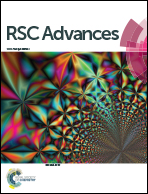Strategic tuning of excited-state properties of electroluminescent materials with enhanced hot exciton mixing†
Abstract
Deep blue emitters with excellent stability, high quantum yield and multifunctionality are the major issues for full-color displays. In line with this, new multifunctional, thermally stable blue emitters viz., N-(4-(10-(1-(2,3-dihydrobenzo[b][1,4]dioxin-6-yl)-1H-phenanthro[9,10-d]imidazol-2-yl)anthracen-9-yl)phenyl)-N-phenylbenzenamine (DPIAPPB) and 2-(10-(9H-carbazol-9-yl)anthracen-9-yl)-1-(2,3-dihydrobenzo[b][1,4]dioxin-6-yl)-1H-phenanthro[9,10-d]imidazole (CADPPI) with hybridized local charge transfer state (HLCT) and hot exciton properties have been synthesized. These molecules show high photoluminescence quantum yield (Φs/f): (DPIAPPB – 0.82/0.70 and CADPPI – 0.91/0.83). The CADPPI based device (EL – 467 nm) shows high efficiencies [ηc – 9.85 cd A−1; ηp – 10.84 lm W−1; ηex – 4.78% at 2.8 V; CIE (0.15, 0.10)] compared to the DPIAPPB device (EL − 472 nm) [ηc – 6.56 cd A−1; ηp – 6.16 lm W−1; ηex – 4.15% at 2.8 V with CIE (0.15, 0.12)]. The green device with CADPPI:Ir(ppy)3 exhibits a maximum L – 59 012 cd m−2; ηex – 16.8%; ηc – 37.3 cd A−1; ηp – 39.8 lm W−1 with CIE (0.30, 0.60) and the red device with CADPPI:Ir(MDQ)2(acac) shows a maximum L – 43 456 cd m−2; ηex – 21.9%; ηc – 36.0 cd A−1; ηp – 39.6 lm W−1 with CIE (0.64, 0.35).



 Please wait while we load your content...
Please wait while we load your content...